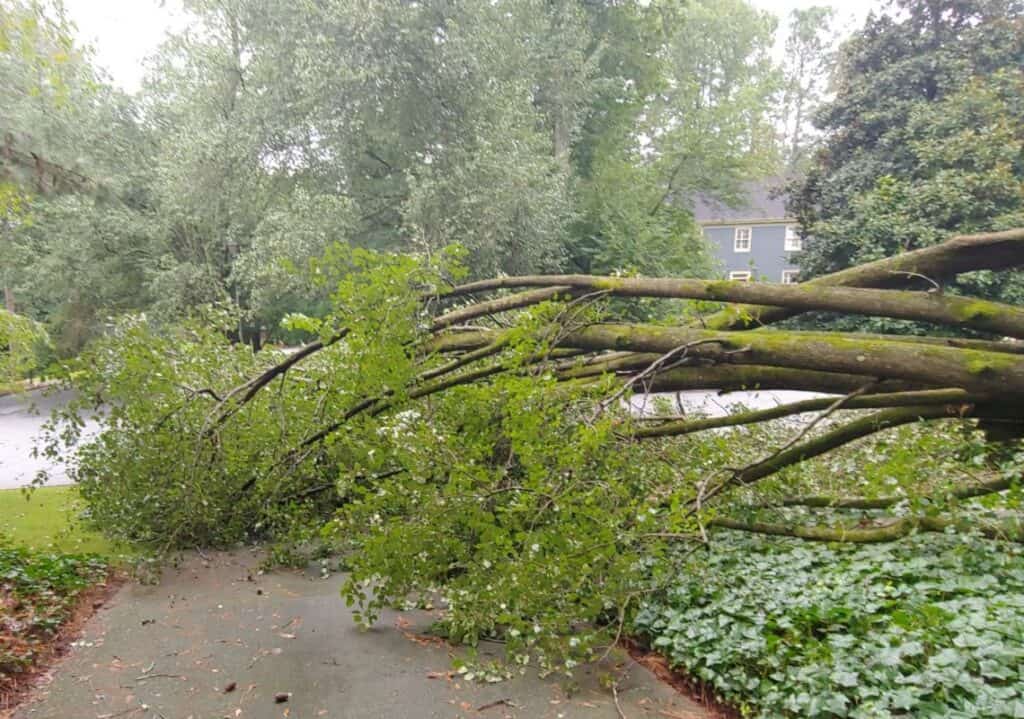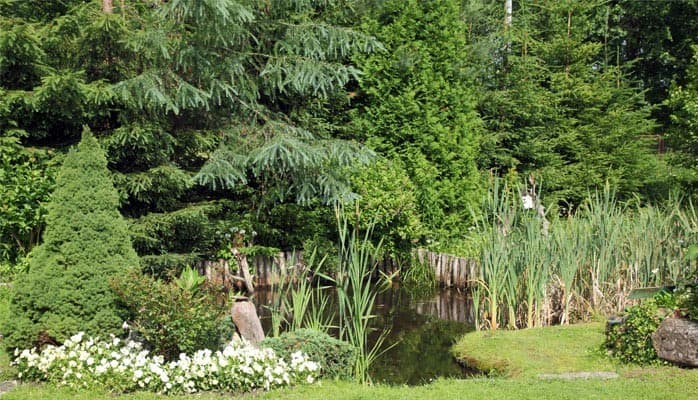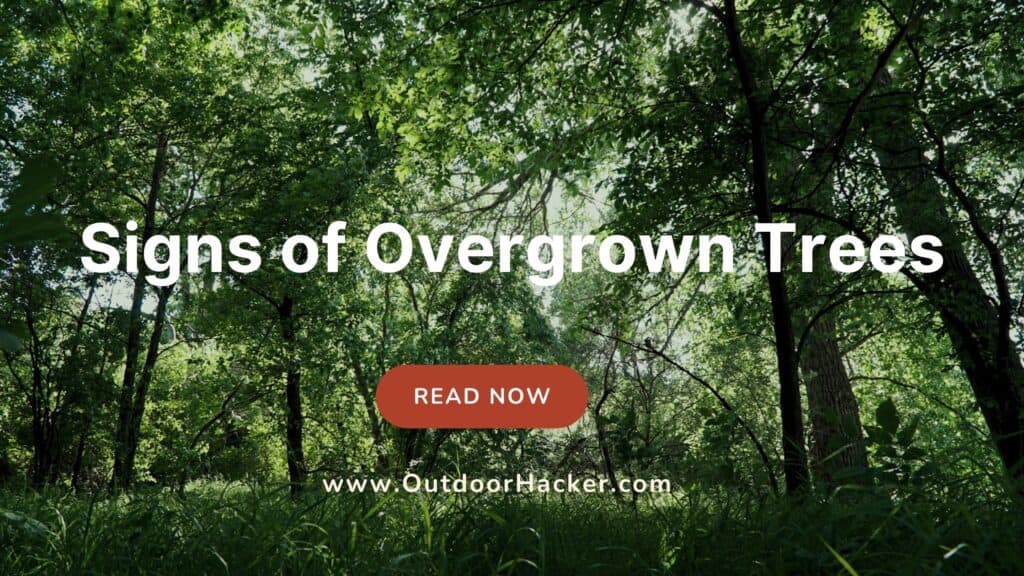Towering trees are a majestic sight. They beautify gardens, offer shade on hot summer days and serve as cozy havens for woodland creatures. However, just like any living thing, your leafy companions can become overgrown, posing a risk to themselves, those around them and their surroundings.
The National Storm Damage Center estimates that falling trees cause more than $1 billion in property damage each year in the United States.
Whether you’re a seasoned gardener or a new nature enthusiast, knowing how to identify or finding the signs of overgrown trees is an important skill. How do you know when these green giants have gone from statuesque to overgrown? Here are 10 signs of overgrown trees to watch out for.
Table Of Contents
Why Tree Maintenance Matters?
Regular tree maintenance is crucial for:
- Ensuring the health and longevity of trees
- Preventing property damage
- Enhancing landscape aesthetics
- Promoting safety in your outdoor spaces
Signs of Overgrown Trees
1. Dense, Overcrowded Canopy

A blanket-like canopy is one of the most apparent signs of an overgrown tree. While a full, lush tree might look healthy at first glance, excessive foliage can be problematic.
A tree’s canopy should allow some light to pass through. If it’s too dense, very little sunlight reaches the ground. Plants and grass beneath the tree are denied this essential resource, and you may notice stunted growth.
It also prevents sunlight and air from reaching the inner branches, instigating poor growth and increasing the risk of disease.
For campers and hikers, dense canopies create darker, damper environments that are more hospitable to pests and critters like snakes and that make navigation difficult.
Due to the added weight, an overcrowded canopy also increases the risk of the tree toppling in strong winds.
Here’s what to look for:
- Branches that are tightly packed together
- Difficulty seeing the sky when looking up through the tree
- A lack of light penetration to the inner parts of the tree
A healthy pruning can help thin out the canopy. This will allow more sunlight through, promoting healthy growth.
Some invasive species also have thick canopies. For example, the Eastern red cedar’s canopies block up to 60% of annual rainfall — an issue that’s negatively impacting grasslands throughout the central United States.
2. Branches Touching Structures or Power Lines
If you live in an urban setting, one of the clearest indicators that a tree needs some TLC is if it starts to interfere with human-made structures. If the branches are making contact with nearby buildings, fences, or power lines or are infringing on your neighbors’ property, it’s time for some pruning.
Over time, these overgrown features brush up against homes or sheds. Scraping roofs or walls — particularly during storms — weakens the structure and potentially creates access points for pests. Branches near power lines pose serious safety risks and can cause outages or fire risks.
If you notice branches near power lines, contact your local utility company rather than attempt to prune the tree yourself.
3. Dead or Dying Branches
Dead or decaying branches indicate that a tree is overgrown and struggling to sustain its current size. These branches often appear brittle and bare and might break off easily in light winds. Ignoring dead limbs can increase the risk of accidents, as these branches can fall unexpectedly.
Dead branches also signal that the tree is not distributing nutrients evenly. When a tree has grown out of control, it strains the tree’s oxygen and water use, leaving it unable to sustain life in all of its branches. Pruning them helps the tree redirect its energy toward healthier growth.
4. The Shedding Storm

Is your backyard constantly covered in a layer of leaves, twigs and dead branches, even outside of fall? While some leaf litter is natural, excessive debris falling from a tree can be a sign of overgrowth.
If you notice an increase in falling debris, consider pruning the tree to remove weak branches. However, you may want to check if the shedding is caused by disease or pest infestation first.
5. Lopsided and Leaning
Trees have a natural shape. A pine will be more conical, while an oak might have a broad, spreading canopy. However, if a tree’s branches are all on one side, leaning heavily in a particular direction, it could be struggling to support its weight. This is often caused by uneven growth due to lack of sunlight or damage from wind or storms.
While some species, like cook pines, naturally grow at an angle, an excessive tilt can be a red flag. A leaning tree poses a serious hazard to anyone nearby, particularly during storms, and may need to be pruned or removed.
However, removal is only recommended when no other measure can be applied. If you choose this line of correction, find a safe way to remove the tree, use the right equipment, and determine how you will use or dispose of the fallen tree. You can chop it up and use it as firewood for heating or cooking, donate it to local lumber or mills, sell it to homesteaders, or turn it into compost.
6. Roots Causing Damage
Overgrown trees don’t just affect what’s above ground — their roots can also become problematic. If you notice roots lifting sidewalks, driveways or foundations, it could indicate your tree is overgrown. In some cases, the root system may become exposed, which implies that the tree’s natural growth area is too small. This happens frequently in highly developed environments where space is limited.
Overgrown roots can cause long-term damage and should be addressed sooner rather than later.
7. Attracting Too Many Pests
Lush trees provide perfect shelter for animals like squirrels, insects and birds. While some wildlife is natural and expected, an infestation could be problematic. Too many pests can damage the tree’s health by eating leaves, burrowing into branches or laying eggs in the bark.
Seeing a noticeable increase in unwanted animals around your trees could indicate it’s time for maintenance.
8. Blocking Views or Access

While trees are beautiful, they shouldn’t block important views, walkways or driveways. If leafy companions obstruct your ability to see, park or enjoy your property, it’s time to trim them back. Clearing out overgrown branches can restore your view and improve safety.
9. Time to Prune
Sometimes, the best indicator that maintenance is past due is simply the passage of time. These green giants should be pruned regularly. If you can’t remember the last time you pruned the trees, it’s probably time for a trim.
10. Fungus Growth
While not always directly related to overgrowth, the presence of fungal bodies or visible decay can indicate that a tree has been neglected or is struggling due to its size. Overgrown trees, especially those with dead or dying branches, are more susceptible to fungal infections. These infections weaken the tree from the inside, affecting its health and making it more likely to fall apart.
To detect a fungus invasion, check for the following:
- Mushrooms or bracket fungi on the trunk or major branches
- Soft, crumbly or discolored areas on the tree
- Cavities or holes in the main structure of the plant
Regular pruning and care can help prevent fungal growth by improving air circulation and removing infected branches.
What You Can Do Now?
If you’ve spotted some of these signs in your favorite tree, don’t despair. You can help your leafy friend get back on track with a little intervention. Here’s what you can do:
- Know your species: Different trees have different growth habits. Research your specific type to understand its natural form and pruning needs. If you’re rearing them in a greenhouse, the internal conditions might instigate rapid growth, so check the temperature and humidity levels and adjust as appropriate.
- Consult a certified arborist: Reach out to a tree doctor to assess your wooded patch and recommend the best course of action. This might involve pruning to remove overgrown branches and deadwood or uprooting a whole tree to prevent root invasion.
- DIY or call in the pros: Some folks might feel comfortable tackling minor tasks like removing dead branches themselves. However, for major work, it’s always best to call in the professionals to determine the proper course of action.
- Safety first: Always prioritize safety when conducting any yard work. Refrain from tasks that seem beyond your skill set or put you at risk of injury.
How to Cut a Big Tree: Safety First
When dealing with overgrown trees, safety should be your top priority. Here are some tree cutting ideas and tips:
- Assess the situation: Determine if you can handle the job or if you need professional help.
- Use proper equipment: Ensure you have the right tools, including safety gear.
- Plan your cuts: Decide where to make cuts to minimize damage and ensure safe falling.
- Create a safety zone: Clear the area around the tree.
- Make a notch cut: This determines the falling direction.
- Perform the felling cut: Make this cut on the opposite side of the notch.
Remember: For large trees or complex situations, always consult a professional arborist.
Conclusion:
Also, when it comes to nature, most of the biggest problems often start small. By learning to identify the signs of an overgrown tree, you can take action and ensure that these majestic giants continue to thrive for generations.
Additional Resources:
- International Society of Arboriculture: Expert advice on tree care
- USDA Forest Service: Information on tree species and management
- Tree Owner’s Manual: Comprehensive guide for tree care






















